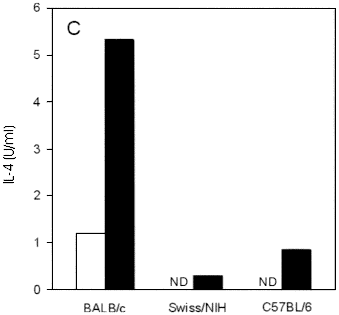Infection of Swiss/NIH mice with Leishmania major was compared with infection in isogenic resistant C57BL/6 and susceptible BALB/c mice. Swiss/NIH mice showed self-controlled lesions in the injected foot pad. The production of high levels of interferon-<FONT FACE="Symbol">g</font> (IFN-<FONT FACE="Symbol">g</font>) and low levels of interleukin-4 (IL-4) by cells from these animals suggests that they mount a Th1-type immune response. The importance of the indigenous microbiota on the development of murine leishmaniasis was investigated by infecting germfree Swiss/NIH in the hind footpad with L. major and conventionalizing after 3 weeks of infection. Lesions from conventionalized Swiss/NIH mice were significantly larger than conventional mice. Histopathological analysis of lesions from conventionalized animals showed abscesses of variable shapes and sizes and high numbers of parasitized macrophages. In the lesions from conventional mice, besides the absence of abscess formation, parasites were rarely observed. On the other hand, cells from conventional and conventionalized mice produced similar Th1-type response characterized by high levels of IFN-<FONT FACE="Symbol">g</font> and low levels of IL-4. In this study, we demonstrated that Swiss/NIH mice are resistant to L. major infection and that the absence of the normal microbiota at the beginning of infection significantly influenced the lesion size and the inflammatory response at the site of infection.
Leishmania; Swiss mice; Microbiota; Germfree; Th1; Leishmaniasis









